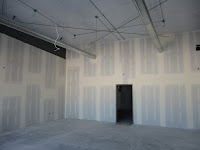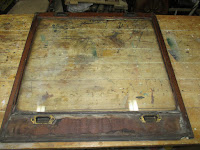Snow, cold, and hazardous driving have slowed down progress somewhat, but today I got back to work as promised. After consulting with Tim, we decided that the west end of the canvas on the 453 needed to be revised to pull at a more horizontal angle. Luckily the straps on our ratchets are long enough to make this a relatively simple proposition, as seen here.
As we saw earlier, originally I had been pulling the canvas straight down over the end of the car. Tim graciously allowed me to use the 1754 as an anchor. And I hope nobody will need to move that traction motor for the next week or two.
This allowed me to pull out at least 4 1/2" at the west end:
And after re-rigging the straps at the east end, I got a couple of inches there also. That may not sound like much in a length of 60', but the canvas was already pretty tight and I hope in the next week or so that we can pull out some more. Then I can start tacking.
I also had to loosen some of the clamps pulling the canvas side to side, reposition them, and so on. There's a lot of up-and-down, back and forth climbing required to get the canvas tensioned properly. After all this rigging, I almost think I'm ready to set sail with Captain Bligh. "You men don't know wood from canvas, but I'm going to teach you!!"
The repainted doors for the 160 that Pete and Henry have been working on really look nice.
As we've pointed out before, the North Shore used decals for its interior lettering, whereas the CA&E seems to have stuck with hand-painted lettering. Take your pick -- with stencils you can have lots of words as seen here. The CA&E cars just say "DO NOT PASS FROM CAR TO CAR".
And Tim continues to make progress on the ticket booth.
It takes a real sense of humor to label the exit door "PULL" when there's nothing to pull on.
(Sorry - you can't read it due to the lighting, but the sign on the right stile says "PULL")
And the magic fare register actually works -- he demonstrated it for me.
Steve Sanderson was working on parts for the Electroliner in the shop, though I didn't catch him on camera.
Then I went over to the Shaker Heights 18 to remove some windows to take home and rebuild. With the lights working and most of the tools sorted out, it looks pretty good.
These windows will be back in place before you know it.


















































